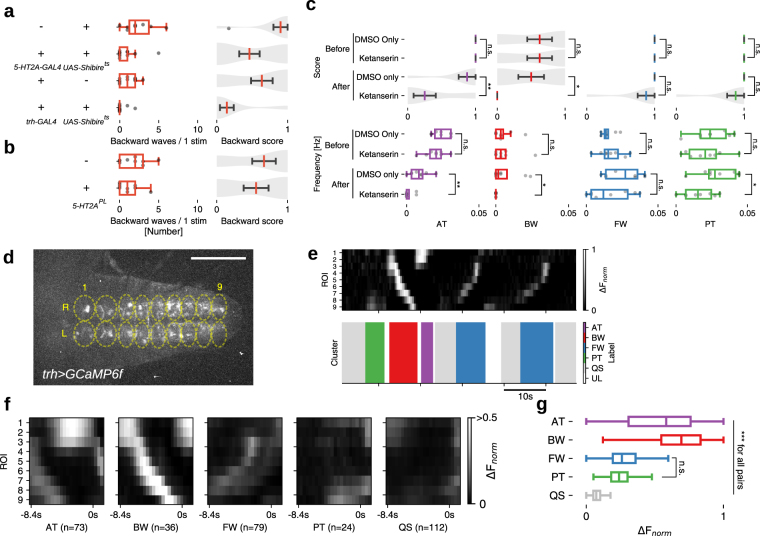Figure 7.
Implication of the serotonergic system in backward locomotion. (a) 5-HT2A-GAL4 and serotonergic neurons are required for proper backward locomotion. Quantification of backward locomotion as in Fig. 6b when 5-HT2A-GAL4 or trh-GAL4 targeted neurons are thermogenetically inhibited (n = 10, 13, 11 and 14 from top to bottom). p = 0.004 (waves), 0.016 (score) for 5-HT2A > Shibirets, p = 0.005 (waves), 0.006 (score) for trh > Shibirets. (b) 5-HT2A homozygous mutants (5-HT2APL) did not show significant difference in backward locomotion. n = 9, each group. p = 0.19 (waves), 0.32 (score) for 5-HT2APL. *p < 0.05, **p < 0.01, Mann-Whitney U test. (c) A 5-HT2 antagonist, Ketanserin, reduces fictive backward locomotion. Motor patterns were extracted from activity data of 5-HT2A, RRa > GCaMP6f. p = 0.001 (waves), 0.002 (score) for AT, p = 0.023 (waves) 0.016 (score) for BW, p = 0.15 (waves), 0.02 (score) for PT, otherwise p > 0.05. (d–g) Calcium imaging of serotonergic neurons. (d) Neural activity in trh > GCaMP6f larvae was captured using 18 ROIs. (e) Extracted motor patterns. Preprocessed fluorescence pattern (top) and assigned motor patterns (bottom). (f) Mean activity pattern aligned with the end point of each motor pattern. Average duration of each motor pattern were AT:2.2 ± 0.2 s, BW:2.6 ± 0.1 s, FW:1.8 ± 0.1 s, PT:1.5 ± 0.1 s, QS:9.1 ± 0.8 s, (mean ± standard deviation). (g) Maximum fluorescence change during each motor patterns. ***p < 0.001, ANOVA with post-hoc Tukey HSD test. Scale bar 100 μm. See also Fig. S7.

